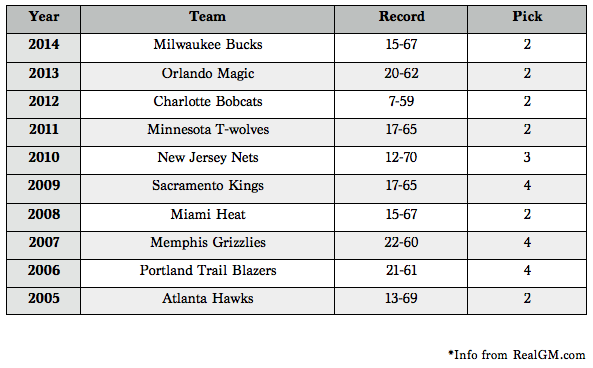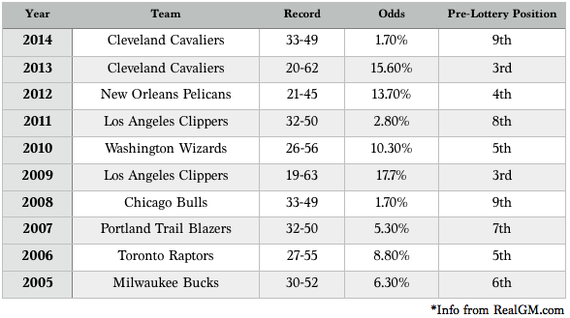Determining who picks where in the NBA Draft has gone through a whirlwind of change in the history of the league. According to NBA.com, from 1947-1965, the teams with the worst overall records benefited and were able to pick in reverse order of their win-loss record. However, there was a territorial pick rule that allowed an NBA team to draft a player from its local area. This is how the Boston Celtics were able to draft players like Hall of Famers Bob Cousy and Tommy Heinsohn, who both played at my alma mater, College of the Holy Cross, located in Worcester, Massachusetts. This was allowed mainly when teams were struggling to gain fan bases. Before the start of the draft, a team could forfeit its first-round pick and instead select a player from its immediate area. Heinsohn, for example was loved at Holy Cross, and thus the Celtics gained more of a following, and also a player who went on to average 18.6 points and 8.8 rebounds, who led the team to eight NBA championships in his nine-year playing career.
In 1966, the NBA introduced a coin flip method between the worst teams in each division (there were two divisions at the time) to determine who would receive the first overall pick. The rest of the first-round picks were determined in reverse order of their win-loss record. This system was used until 1984, but was thought of as flawed because the second-worst team would never have the ability to win the No. 1 overall pick if it was in the same division as the worst team.
In 1985, the first lottery system was introduced. Reports were out and it seemed fairly obvious that the Houston Rockets were purposely losing games in order to lock up the first overall pick. Other teams were also deliberately losing games. How the early lottery system worked was that each non-playoff team had an equal shot of getting the first pick, and envelopes of each team were put in a hopper and pulled out one-by-one. The jackpot of this first lottery was Georgetown center Patrick Ewing? Ever hear of him? All seven teams who didn't make the playoffs had an equal shot of landing the first overall pick, and the New York Knicks got lucky, as Ewing led them to the playoffs in 13 of his 15 seasons.
After NBA officials decided this didn't work, in 1987, they introduced a system in which only the top three picks would be subject to a lottery. After those were established, the remaining non-playoff teams would pick in reverse order of their win-loss record. This essentially meant that the worst team in the league wouldn't be dropped past the fourth overall pick, the second-worst team wouldn't be dropped past the fifth overall pick, and so on and so forth.
In the earlier drafts, teams would select players until they ran out of prospects. For example, according to NBA.com, the 1960 draft went 21 rounds. In 1974, it went 10 rounds. It was shortened to seven rounds in 1985, but in 1989, it was shortened to the current system of just two rounds. Since the draft went to two rounds, eight second-round picks have done on to become All-Stars and two, Ben Wallace and Brad Miller, were the only undrafted players to make an All-Star team.
Since 1990, the NBA has been using a weighted lottery system, which gives the worst team in the league the best chance to land the No. 1 pick, but also gives others outside chances of landing it. The way the lottery works is that 14 ping pong balls numbered 1-14 are placed in a standard lottery machine. Four balls are then drawn randomly to determine the winner of the top three picks in the draft. The order of the numbers drawn isn't important as 1-2-3-4 is considered the same as 2-3-1-4. Each team in the lottery is assigned to a certain amount of these four-digit combinations. This season, since the Milwaukee Bucks ended the season with the worst record, they got 250 out of 1,000 number combinations available. The Suns, who had the best record in the lottery, got only five combinations.
Is this system working? Let's take a look at how the lottery turned out in the last 10 years. Note that the teams shown here do not represent the team who necessarily ended up making that particular selection. For instance, the 2011 Los Angeles Clippers pick was made by the Cleveland Cavaliers, after the Clippers gave the Cavs a first-round pick to take Baron Davis off their hands. That worked out pretty well for the Cavs, as they were able to add Kyrie Irving to their roster. Here are the teams who won the lottery in the past 10 seasons:
As you can see, not a single team with the worst record in the league received the first pick in the draft in the last 10 seasons. This week, the Cleveland Cavaliers were able to land the first overall pick with just 1.70% odds of doing so, which is tied with the Chicago Bulls in 2008, as the teams with the smallest odds of receiving the No. 1 overall pick over the last decade. Looking further, no team with the worst or second-worst record was awarded the first overall pick in this span. But, does this prevent tanking?
This is how this year's lottery on May 20, 2014 played out:
The Milwaukee Bucks and Philadelphia 76ers were hands-down the two worst teams in the NBA this season. Both could have been accused of tanking. However, it worked out for them, as they landed in the top 3, where either Andrew Wiggins, Jabari Parker, or Joel Embiid -- the top three prospects in the loaded 2014 draft class -- will be available. Looking at the pre-lottery positions, picks 10-14 were spot on, while picks 2-9 were skewed by one spot below their projected value due to the Cavaliers earning an improbable first overall selection.
Is it really worth tanking? Let's look at where each team who had a No. 1 overall pre-lottery position, and thus the worst record in the league, ended up picking in the draft over the last 10 years.

Over the last 10 years, only the 2009 Sacramento Kings and the Memphis Grizzlies have received the worst-possible pick for the worst team in the league. In 6-out-of-10 years, the worst team in the league has received the No. 2 pick. The Orlando Magic’s lottery win in 2004 was the last time the worst team has landed the first overall selection.
Is it worth tanking? The 2014 Cavaliers would say no (because they got lucky... cue the conspiracy theorists), but looking at the past, teams might be happy with landing a top 4 pick for being the worst team and the biggest joke on the court for a season.
Tradesports.com is the first and only fantasy sports experience where sports fans can play in real-time for real money. Follow @TradesportsUS.

